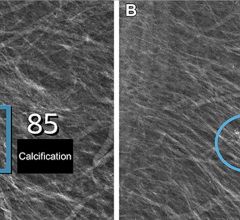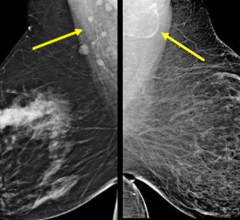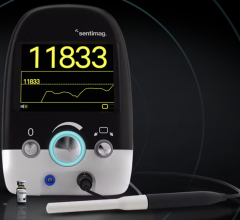
RAA provides a comfortable and welcoming environment filled with light and color.
When it comes to developing a state-of-the-art women’s imaging center, getting a clearer view of breast cancer is part of a much bigger picture. For the professionals at Radiology Associates of Albuquerque (RAA), NM, adopting digital technology was just one aspect of the center’s drive to become the best practice of its kind in the state.
“It was more than just transitioning from analog to digital mammography,” RAA’s Technical Director and Lead Technologist Michele Duran, R.T., R.D.M.S. said. As she noted, the development of the women’s health arm of RAA, High Resolution, was “part of a philosophical decision to combine the mammography services of two centers, convert to digital mammography, and provide services unlike any other center in New Mexico.”
The architect of the ambitious undertaking was Gary L. Wood, M.D., director of Breast Imaging for RAA. Dr. Wood envisioned a comprehensive practice that would serve patients from routine screening to pre-surgical planning and post-surgical follow-up. To that end, he assembled a multidisciplinary panel of radiologists, pathologists and breast surgeons, along with radiation and medical oncologists.
“Our collaboration with our colleagues in other disciplines of breast cancer treatment allows us to have a comprehensive, multidisciplinary approach that takes advantage of standardized practices and policies to serve patients in the best manner possible,” Dr. Wood explained. “When the entire team is working together with a common underlying philosophy and approach, patient care is maximized over individual practice habits and philosophy.”
Designed for Digital
When the promise of digital mammography was supported by the results of the Digital Mammographic Imaging Screening Trial (DMIST) – which demonstrated that digital mammography could find more breast cancer, including in women with denser breast tissue - Dr. Wood worked with Michele Duran and his on-site team to design the new digital environment. “Without digital, we believe we could not offer the same level of service and certainly not undertake the volume of patients that the move to digital provides,” he noted.
Duran visited a number of other imaging centers to get a feel for the ideal workflow that would accommodate the transition from eight analog to four digital mammography machines.
Today, two technologists staff each screening room, with each performing 25 to 30 screening studies per day. “It may seem like the patient has less time in the exam room, but by changing patient workflow to improve efficiency, we actually have more time to talk to the patient.”
“Our practice is clinically oriented, and therefore we tend to see a lot more patients for initial evaluations and workups prior to any surgical visit,” noted Dr. Wood. “We also see a large number of diagnostic cases of patients of all ages, from a young 20-year-old woman with a fibroadenoma to an elderly person with a new mass. The benefit of digital mammography gives us and our patients the comfort of knowing we have the best available technology to help evaluate their problem.” Of the center’s 25 radiologists, four specialize in performing breast imaging. Quite simply, he said, “It’s better for the patients.”
From Screening to Post-Op,
a One-Stop Center
High Resolution took the additional step of providing office hours for breast surgeons so that patients could have most of their diagnostic issues managed in one place. “If a patient is newly diagnosed with breast cancer, the radiologist can set them up for the pre-operative onsite MRI examination as well as for the surgical consultation. At that point, if they need more imaging, which they can get right here – all in one stop,” Duran explained. “We don’t have to print the images, then schedule the patient to see a surgeon on another day. To have access to the latest technology and to get as much care as possible all under the same roof is extremely beneficial for the patient.” The center’s goal is to provide an opportunity for patients with breast cancer to meet with the interdisciplinary team – the radiologist, surgeon and oncologist – to get input from all of the different specialists at the same time.
Hologic’s Host of Complementary Technologies Fit the Bill for High Resolution
Dr. Wood’s strong belief in consistency extended to his choice of technology providers as well. “When all the equipment is the same, the efficiency certainly increases for the technologists,” he said. “After evaluating all of the products on the market at the time, we felt Hologic was the best. The company shows a commitment to women’s imaging, which reassures us that Hologic will be a strong partner for many years to come.”
In addition to the Hologic Selenia digital mammography, R2 computer-aided detection, and the MultiCare Platinum stereotactic table, the practice uses a number of other Hologic products, including Suros breast biopsy equipment and the Discovery SL bone densitometer. “With regards to Hologic equipment, our technologists have been extremely pleased with its ease of use, dependability and the satisfaction of patients with their experience. We have benefited previously from single-vendor standardization of mammography equipment, and the switch to Hologic has provided the same advantage,” Dr. Wood said. For example, he pointed out that although new and improved, the stereotactic table is similar to the center’s older Hologic Lorad table, and thus does not require a whole new mindset in terms of its operation. High Resolution also offers dedicated breast MRI equipment, and Breast Specific Gamma Imaging (BSGI).
Michele Duran said RAA benefits from using a single women’s imaging vendor and notes that their technologists are extremely pleased with the ease of use, dependability and the satisfaction of patients with their Hologic equipment.
High Resolution’s big picture approach to women’s health – with an emphasis on league-leading technology – is setting the standard for breast imaging practices in New Mexico. “In addition to our strong relationships with colleagues in other disciplines of breast cancer treatment, we have also developed the best technical facility in the state,” concluded Dr. Wood. “We are committed to staying on the forefront of new technologies as they are shown to help in the fight against breast cancer.”




 July 29, 2024
July 29, 2024 








